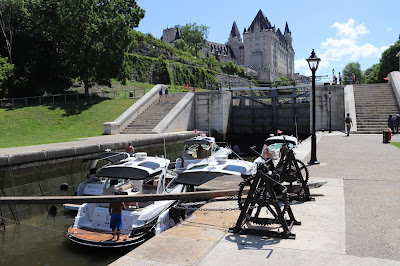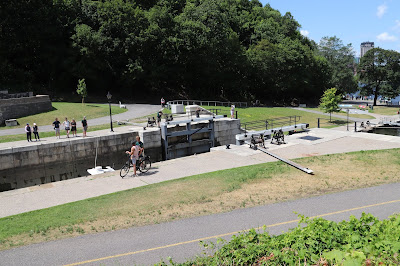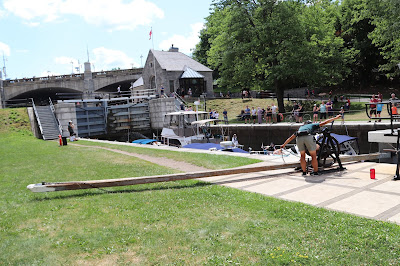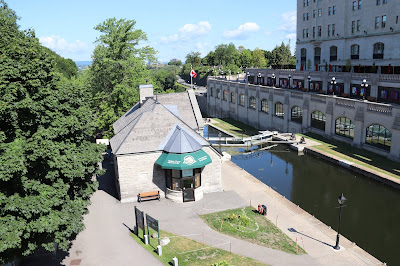 |
| Parks Canada Rideau Canal National Historic Site of Canada Parcs Canada Canal Rideau Lieu historique national du Canada |
The Ottawa Lockstation probably qualifies as the busiest lockstation in the Rideau Canal system. When I photographed the lockstation in July of 2019 a line up of boats waited on the Ottawa River to enter lock 1. Several boats waited on the upper end to enter lock 8. Meanwhile two sets of boats occupied two of the locks on their way to the canal while being lifted 24.1m (79 ft). The Parks Canada Lockstation crew worked continually seemingly without a break—no time to chat.
 |
| Lock 1 |
 |
| Lock 2 |
Building the Rideau:
A Tribute to Sacrifice and Achievement
The engineering marvel known as the Rideau Canal changed the waters of eastern Ontario and their traditional use by the Algonquin of the region forever. Thousands of workers accomplished this project in five years, many working for relatively low wages and some living in shanty towns along the route.
Most of the hard manual labour was done by recent Irish immigrants and French Canadians while some of the skilled labourers were of Scottish and English descent. These workers suffered many hardships including injuries and disease. Hundreds died. Working from dawn until dusk and through the seasons, their backbreaking work was indispensable to the completion of the canal which helped shape this part of Canada.
Rideau Canal construction workers are remembered in communities from Ottawa to Kingston and in cemeteries and memorials in their honour.
Construction du canal Rideau:
Un hommage au chef-d'œuvre d'ingénierie et aux sacrifices
de ses bâtisseurs
Le chef-d'œuve d'ingénierie qu'est le canal Rideau a changé à tout jamais la navigation dans l'Est de l'Ontario et l'utilisation traditionnelle des cours d'eau par les Algonquins de la région. Des milliers d'ouvriers ont travaillé sur ce chantier qui a duré cinq ans. Nombre d'entre eux touchaient de maigres salaires et certains n'avaient d'authres choix que de vivre dans des camps de fortune le long du canal.
La plus grande partie des travaux manuels lourds ont été effectués par des Irlandais fraîchement débarqués en Amérique du Nord et des Canadiens français. Par ailleurs, parmi les ouvriers spécialisés, on trouvait aussi des gens d'origine écossaise ou anglaise. Ces travailleurs ont dû surmonter de nombreuses épreuves, y compris les blessures et la maladie. Des centaines d'entre eux sont morts. Travaillant de l'aube jusqu'au crépuscule, en tout saison, ils exécutaient des tâches très exigeantes pysiquement, mais indispensables pour réussir à terminer le canal, qui a contribué à façonner cette région du Canada.
D'Ottawa à Kingston, leurs tombes sont présentes dans les cimetières et des monuments commémoratifs ont été érigés en leur honneur.
 |
| Lock 3 |
 |
| Lock 4 |
 |
| The Commissariat Building Recognized Federal Heritage Building February 12, 1994 |
 |
| Lock 5 |
 |
| Lock 6 |
 |
| Lock 7 |
Rideau Canal
The Rideau Canal is a chain of lakes, rivers and locks, winding 202 kilometres (121 miles) through the eastern part of the province until it reaches Kingston, on the shores of Lake Ontario. Build between 1826 and 1832 under the direction of Colonel John By of the Royal Engineers, the waterway was intended as a safe rout for the movement of military supplies in case of hostilities between Great Britain and the United States. It soon became a busy water highway, carrying settlers to their new homes and moving the products of the growing settlements to market.
The coming of the railways marked the beginning of a new stage in the history of the canal. Thousands of recreational boaters have since discovered the delight of exploring the history and scenery of Eastern Ontario from the waterway. Today, the canal is maintained and operated by Parks Canada for the enjoyment of all Canadians.
Canal Rideau
Grâce à série d'écluses dans l'est de la province, le canal Rideau relie lacs et rivières sur 202 kilomètres (121 milles) de méandres qui prennent fin à Kingston, situé sur les rives du lac Ontario. Construite entre 1826 et 1832 sous la direction du Colonel John By des Royal Engineers, le canal devait servir de voie navigable sécuritaire pour le transport des fournitures militaires en cas d'hostilités entre la Grande-Bregagne et les États-Unis. Rapidement achalandé, le canal facilite le déplacement des colons vers leurs nouvelles terres et le transport vers les marchés des produits provenant de ces villages en pleine expansion.
Le chemin de fer marqua le début d'un nouveau chapitre de l'histoire du canal. Depuis lors des milliers de plaisanciers y découvrent les joies d'explorer l'histoire et le paysage de l'est de l'Ontario. De nos jours, le canal est entretenu et exploité par Parcs Canada afin que tous les Canadiens puissent en profiter.
Ottawa Locks
Boaters entering the Rideau Canal from the Ottawa River can expect a 1½ hour trip before they finally emerge from the last of the eight locks, to begin their journey southwards through the waterway. This magnificent flight of locks has a lift of 24 metres (79 feet) and is the highest and longest on the canal system. Being locked through is an exciting experience of history, for the locks are still operated by hand as they were when opened to boat traffic in 1832.
Écluses d'Ottawa
Les plaisanciers qui entrent dans le canal Rideau à partir de la rivière des Outaouais doivent patienter pendant une heure et demie avant d'arriver, finalement, à la dernière des huit écluses qui leur ouvra la voie sur le sud. Cette magnifique échelle d'écluses, la plus haoute et la plus longue du réseau, permet de franchir 24 mètres (79 pieds). Ces écluses sont encore actionnées à la main, comme au moment de leur ouverture à la navigation en 1832.
 |
| Lock 8 |
 |
| Lock Office Recognized Federal Heritage Building February 12, 1994 |
Visit the Rideau Canal Index page for more Rideau Canal related posts.























































































































